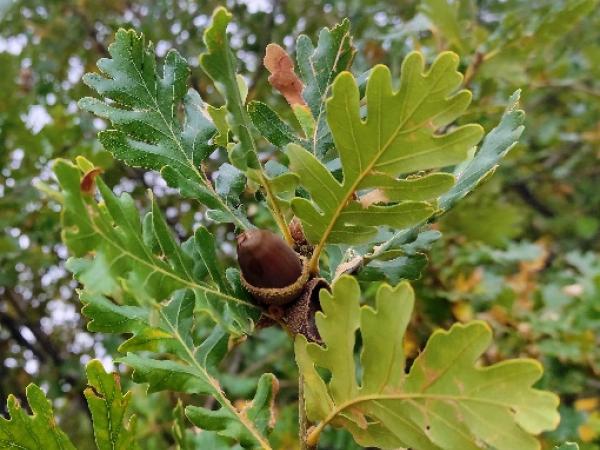Editor's Picks
Plant Focus
First described by the Japanese botanist Bunzō Hayata in 1913, Quercus hypophaea is a medium to large evergreen oak restricted to the southeastern part of Taiwan. It grows in broad-leaved evergreen forests, from sea level up to an elevation of roughly 1,100 m, where it forms dense stands with other oak species. It can reach extensive dimensions, with trunk diameters reported up to 2 meters.

Quercus hypophaea is said to have a large spreading crown giving it a wide and dark appearance. Perhaps this aspect is further strengthened by the bark and branches, which tend to be grayish-brown to deep brown. Its epithet means "dark underneath" (hypo = under + phaeus = color of twilight), in reference to the gray underside of the leaves, but the name also fits with the tree's dusky, dark character!

The leaves of Q. hypophaea are narrowly elliptic or oblong-lanceolate, up to 5–9.5 cm long and 1.5–2.3 cm wide, with a subleathery texture. The abaxial surface is whitish-grey tomentose, covered with appressed hairs (joined by having grown together). The adaxial surface is a pleasant bright green. Petioles are up to 0.5–10 mm long and triangular in cross section, with a dense gray tomentum. The leaf base varies from acute to cuneate and the apex from acute to acuminate. Leaf margins are entire. The midvein is prominent on the abaxial side, but flat adaxially. Secondary veins are clearly visible, in 8–14 pairs, slender and not anastomosing (i.e., they are not interconnected). Tertiary venation is obscured on the abaxial side. Buds are small, rounded, and covered with short white hairs.

The staminate catkins are more or less pendulous, up to 5 cm long. Male flowers are 2.5 mm long and 3 mm in diameter, generally golden yellowish in appearance. The perianth is 5–6 lobed with a puberulent exterior, but glabrous on the inside. Stamens 5–6 with glabrous filaments, up to 1.6 mm long. Anthers 0.9 mm long, puberulent and yellow-gold. Pistillate flowers 2 mm long and 1.5 mm in diameter. Ovary 3-celled, with 2 ovules in each cell. Styles 3, hairy, with apically enlarged stigmas.

The cupule is saucer to disk-shaped, up to 0.5–0.8 cm high and 1–1.8 cm in diameter. The exterior of the cupule is ornamented with a whitish pubescence, and bracts are arranged in 7–11 rings. The nut is oblate to broadly ovoid, up to 1.7–2.1 cm high and 1.2–1.8 cm in diameter. Nut scar 5–8 mm in diameter and slightly convex.

Flowering occurs in December-January, and fruiting takes place in January-February of the second year.

The last assessment for the IUCN Red List was made in 2007, and at that time the species was evaluated as Near Threatened (NT). It has been reassessed in 2020; the new assessment is currently being finalized.
Further reading
Beaulieu, A. le Hardÿ de and T. Lamant. 2010. Guide illustré des chênes. Geer, Belgique: Edilens. Tome 1: 556–557.
Boufford, D.E., H. Ohashi, T.C. Huang, C.F. Hsieh, J.L. Tsai, K.C. Yang, C.I. Peng, C.S. Kuoh, and A. Hsiao. 2003. A checklist of the vascular plants of Taiwan. Flora of Taiwan 6: 15–139 (as Cyclobalanopsis hypophaea (Hayata) Kudo).
Hayata, B. 1913. Icon. Pl. Formosan. 3: 182. https://www.biodiversitylibrary.org/item/66587#page/202/mode/1up
Lee, C.H., H.C. Hsu, C.K. Yang, M.J. Tsai, and Y.F. Kuo. 2019. Identifying Fagaceae Species in Taiwan Using Leaf Images. Transactions of the ASABE 62 (5): 1055–1063., doi:10.13031/trans.13302.
Oldfield, S. and Eastwood, A. 2007. The Red List of Oaks.
Strijk, J.S. 2020. “Quercus hypophaea Hayata”. AsianFagaceae.com – The Complete Database for Information on the Evolutionary History, Diversity, Identification and Conservation of Over 700 Species of Asian Trees. Published on the internet. https://www.asianfagaceae.com/quercus/quercus_hypophaea/ [accessed April 7, 2020]















